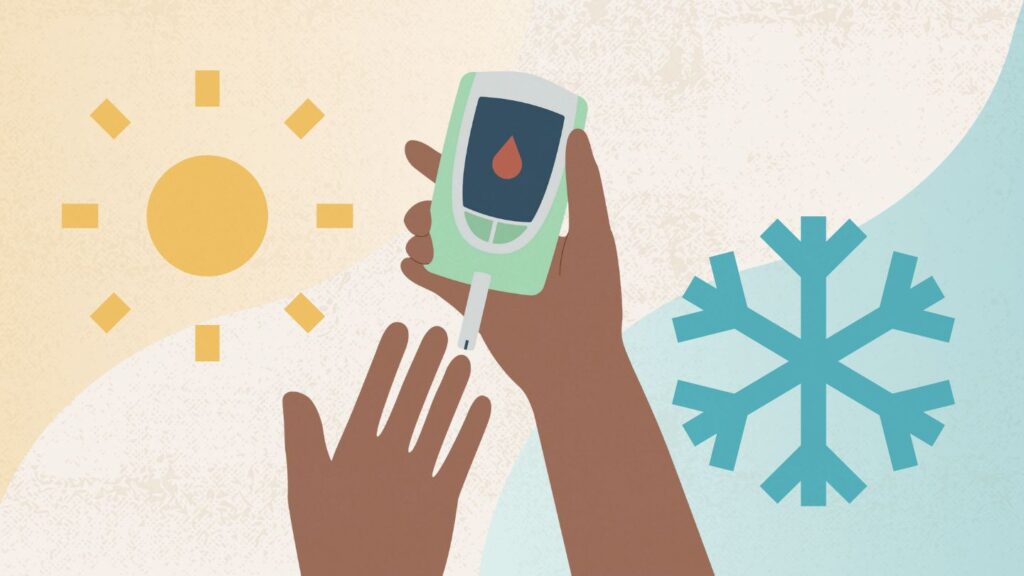Diabetes Care for Autumn
Autumn, with its crisp air and falling leaves, brings about a change in the environment that can impact diabetes management. The shift in temperature, daylight hours, and the seasonal availability of foods all require a different approach to diabetes care.
In this article, we’ll explore how you can adapt your diabetes management routine to ensure a healthy and balanced season.
Monitor Blood Sugar Levels Regularly
The transition from summer to autumn can influence blood sugar levels. Cooler weather and decreased physical activity may lead to more significant fluctuations. Tip: Fill out this form to check if you or a friend qualify for CGMs.
To effectively manage your diabetes during this time, it’s crucial to monitor your blood sugar levels regularly. Keep a close eye on how your body responds to these changes, and make necessary adjustments to your insulin or medication regimen.
Stay Active Despite Cooler Temperatures
As the temperature drops, it can be tempting to stay indoors and reduce physical activity. However, maintaining an active lifestyle is essential for diabetes management.
Autumn offers the perfect opportunity for outdoor activities like hiking, brisk walks, and gardening. Ensure you dress appropriately for the weather and stay active to help regulate blood sugar levels and maintain a healthy weight.
Adjust Your Diet with Seasonal Produce
Autumn introduces a new range of seasonal produce, such as apples, pumpkins, squash, and sweet potatoes. These foods can be incorporated into your diabetes-friendly diet.
Apples are an excellent source of fiber and can help stabilize blood sugar levels. Pumpkins and squash are rich in vitamins and antioxidants, promoting overall health. Take advantage of these seasonal options to add variety to your meals while managing your diabetes.
Mindful Holiday Eating
Autumn marks the beginning of the holiday season, with Thanksgiving and Halloween leading the way. While it’s essential to enjoy these festivities, it’s equally crucial to approach holiday eating mindfully.
Keep portion sizes in check and focus on balanced meals. For individuals with diabetes, stress can affect blood sugar levels. Additionally, limit your intake of sugary treats and monitor your alcohol consumption to prevent blood sugar spikes.
Must Read CGMs in noncritical care hospitals optimizes glycemic control
Vaccinations and Preventive Care
Flu season typically begins in the fall, and individuals with diabetes are at a higher risk of complications from the flu.
Ensure you receive your annual flu shot and discuss other recommended vaccines with your healthcare provider. Staying up to date with vaccinations and preventive care is a fundamental aspect of diabetes management.
Ward Off Seasonal Illnesses
Autumn can bring a variety of illnesses, including colds and respiratory infections. For people with diabetes, these infections can impact blood sugar control.
It’s essential to practice good hygiene, such as regular handwashing, and maintain a healthy immune system. A balanced diet, regular exercise, and adequate sleep all contribute to a robust immune system.
Read Guide about Wegovy Dosage Guide: The Best Way For Weight Loss
Prepare for Daylight Saving Time
The end of daylight saving time in the fall results in shorter days and decreased daylight. This transition can affect your daily routine and potentially disrupt your sleep patterns.
Ensure you adjust your insulin or medication schedule as needed to accommodate the time change. Maintain a regular sleep schedule to promote stable blood sugar levels.
Also, read about 10 Smart Strategies to Trim 100 Calories
Managing Stress
The holiday season can be a source of stress for many people. Stress has the potential to raise or lower blood sugar levels in diabetic persons. Implement stress management techniques such as meditation, deep breathing exercises, or yoga to help maintain a sense of calm and balance.
Regular Check-ups
Autumn is an ideal time to schedule a comprehensive check-up with your healthcare provider. These appointments can help you review your diabetes management plan and make necessary adjustments for the season ahead.
Your healthcare team can also provide guidance on managing diabetes during the changing weather conditions.
Be Prepared for Emergencies
Autumn can bring unpredictable weather, including storms and power outages. Individuals with diabetes should be prepared for emergencies by having a supply of necessary medications, testing supplies, and non-perishable diabetes-friendly snacks. Create an emergency plan that includes contact information for healthcare providers and support networks.
Conclusion
Autumn is a season of transition, and it’s essential for individuals with diabetes to adapt their care routines to the changing environment.
By monitoring blood sugar levels, staying active, adjusting your diet to seasonal produce, and maintaining a healthy lifestyle, you can effectively manage your diabetes during the fall months.
The holiday season also requires mindful eating and stress management to ensure your health remains a top priority.
Regular check-ups with healthcare providers, vaccinations, and preparedness for emergencies further enhance your ability to navigate the season successfully.
With careful planning and the right approach, you can enjoy all that autumn has to offer while maintaining stable blood sugar levels and overall well-being.
Remember that diabetes care is a dynamic process, and adjusting to seasonal changes is an essential part of it.


